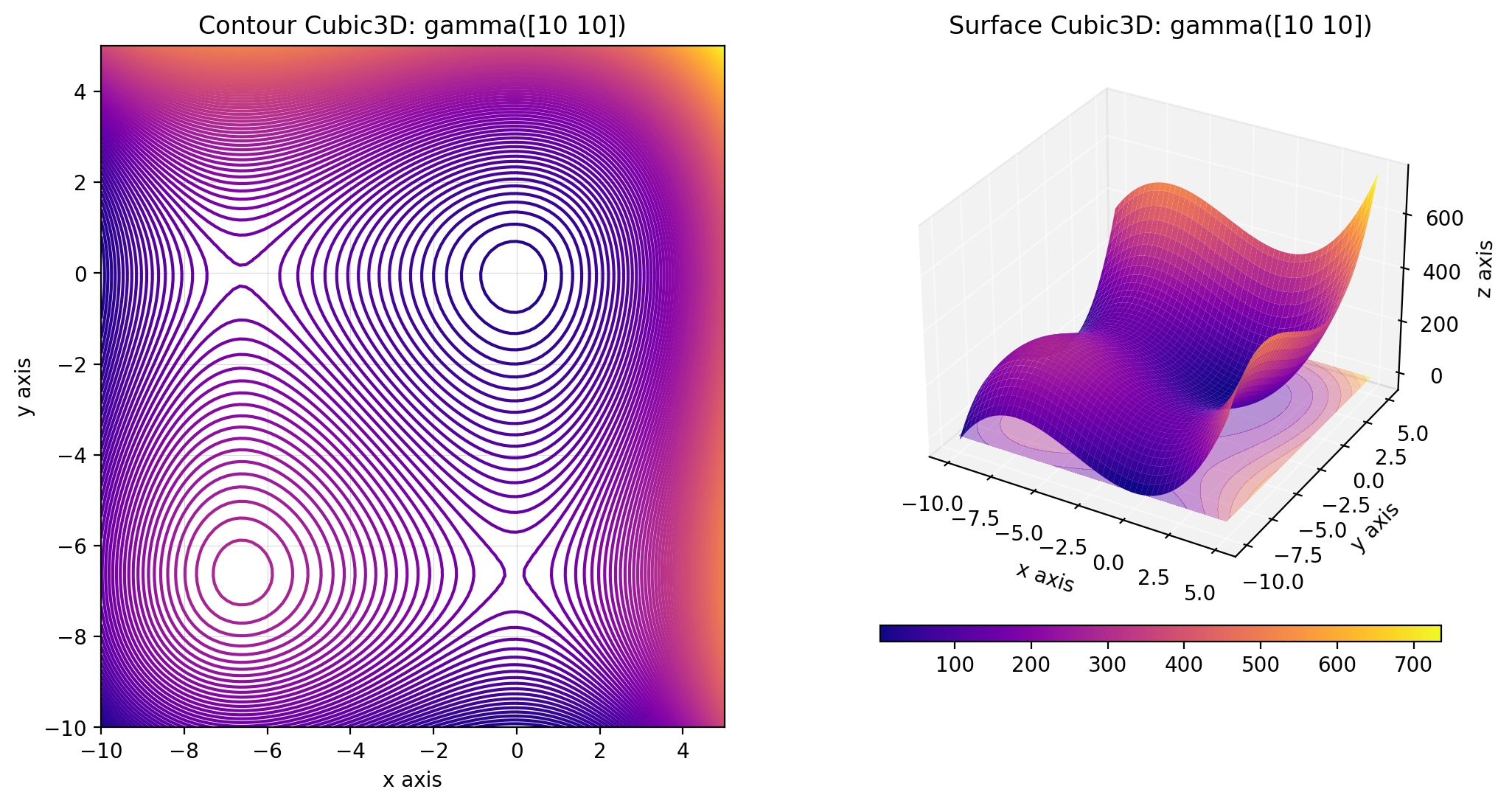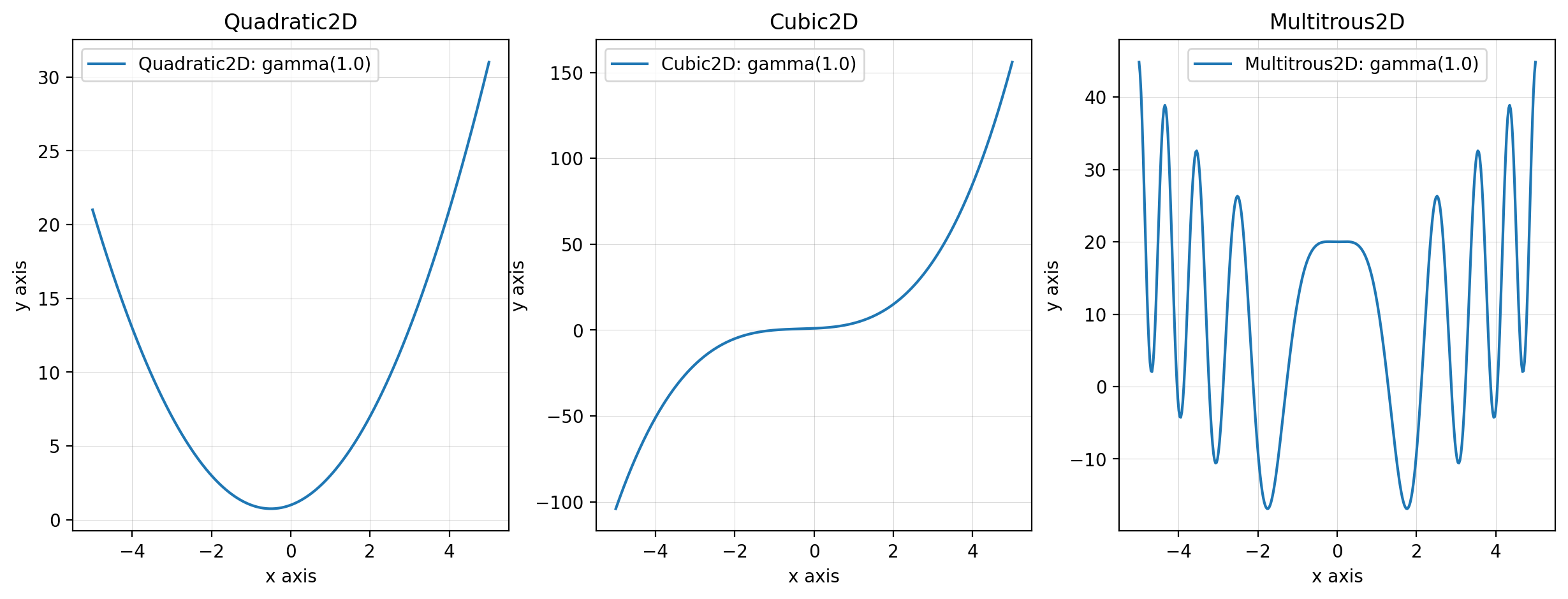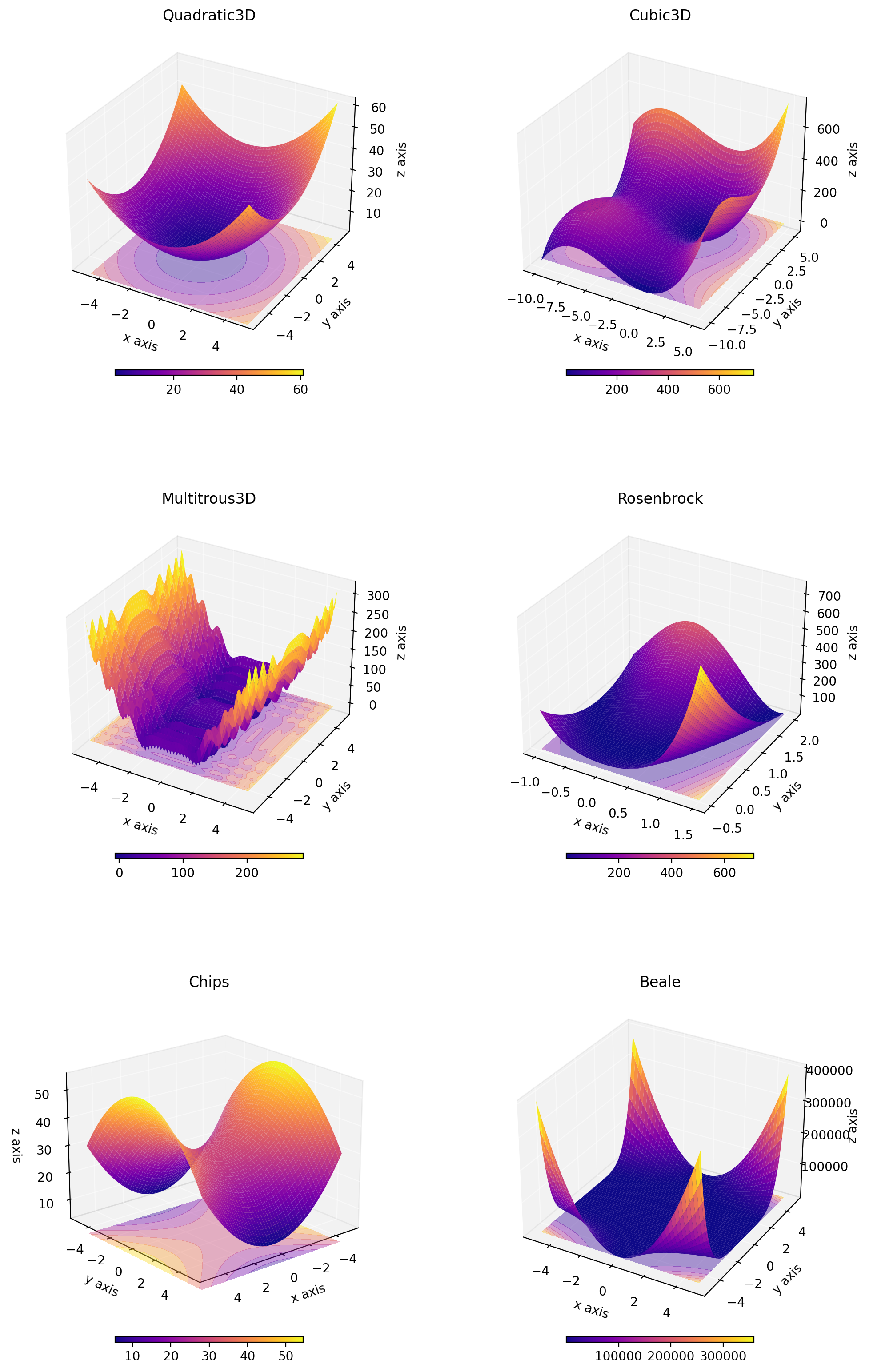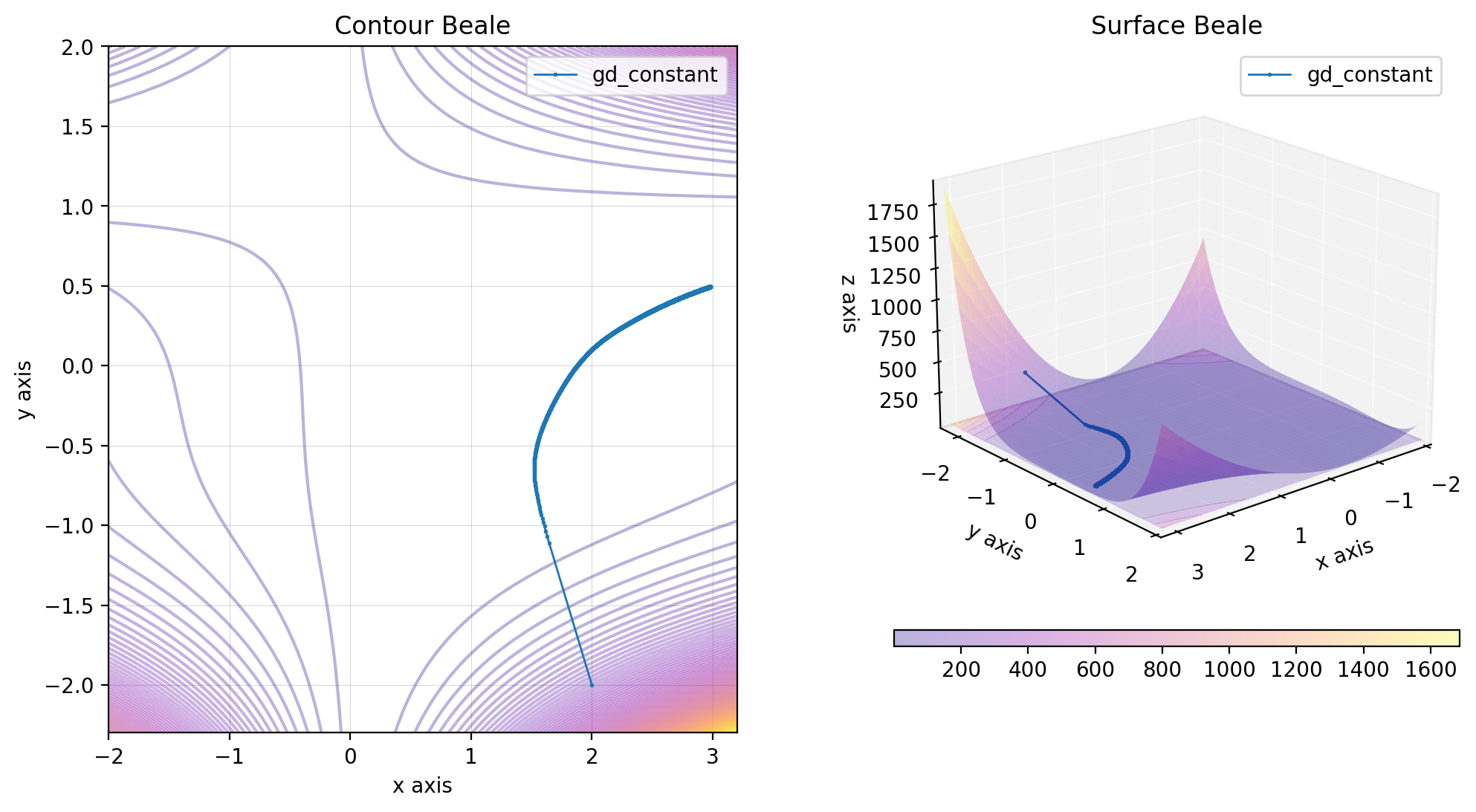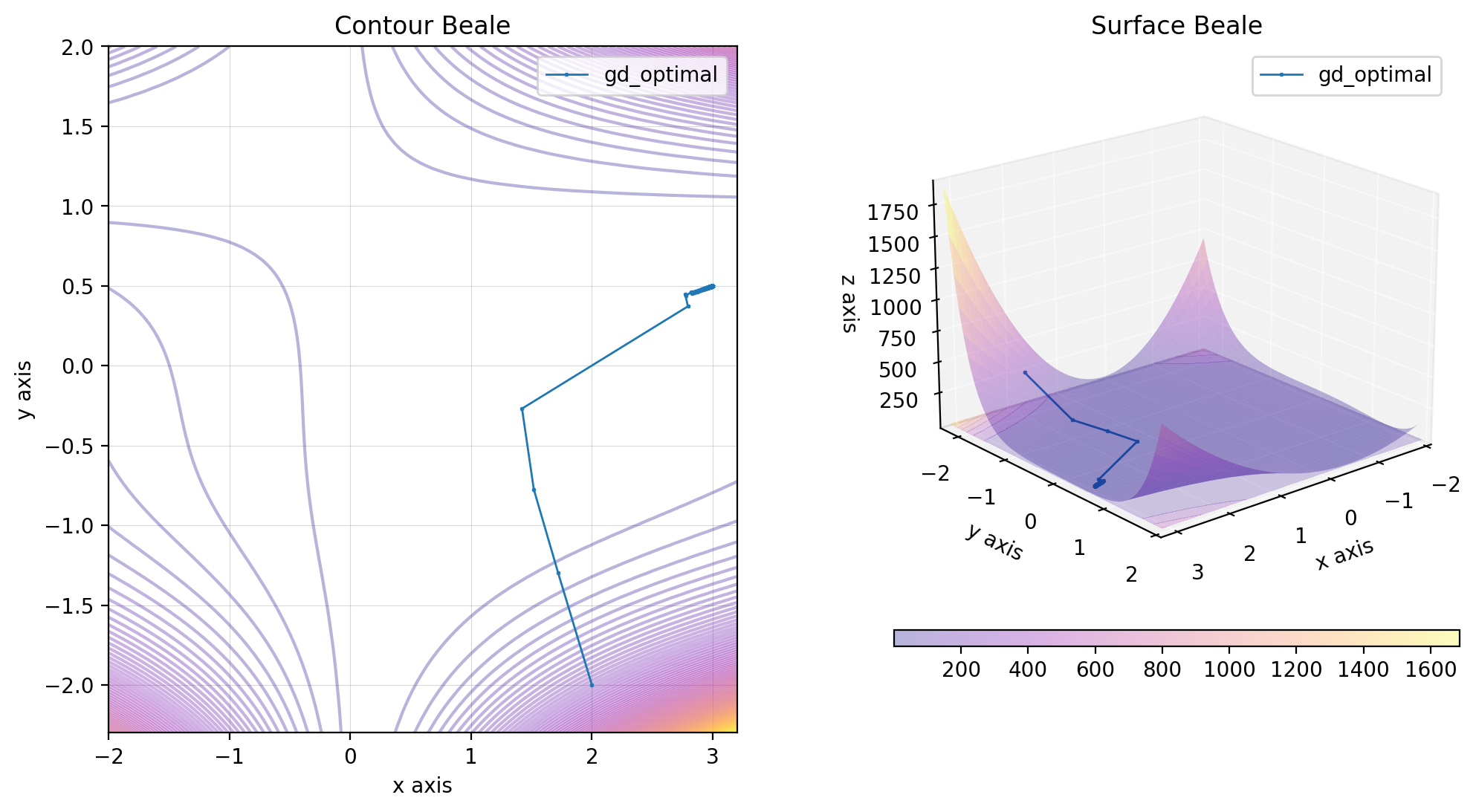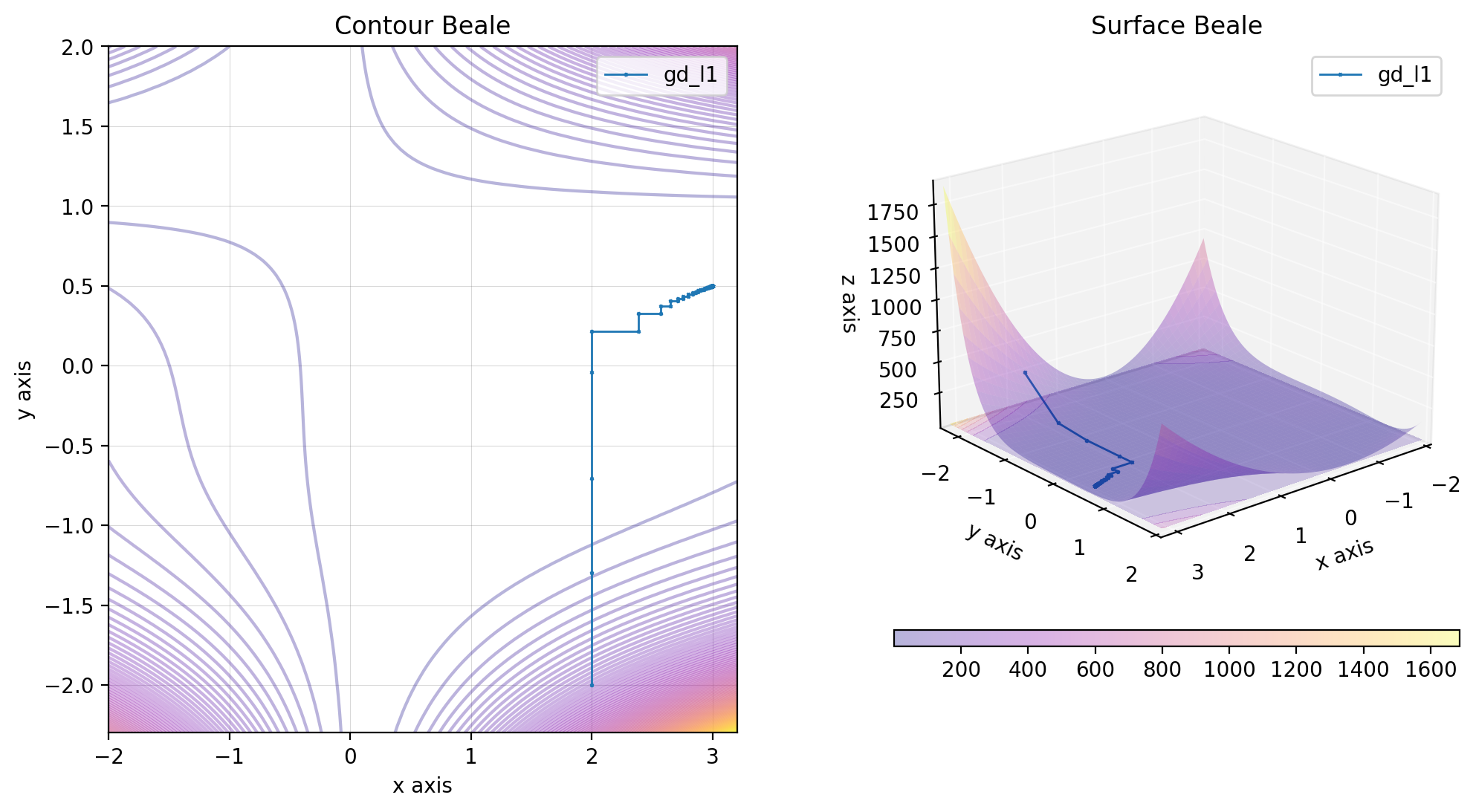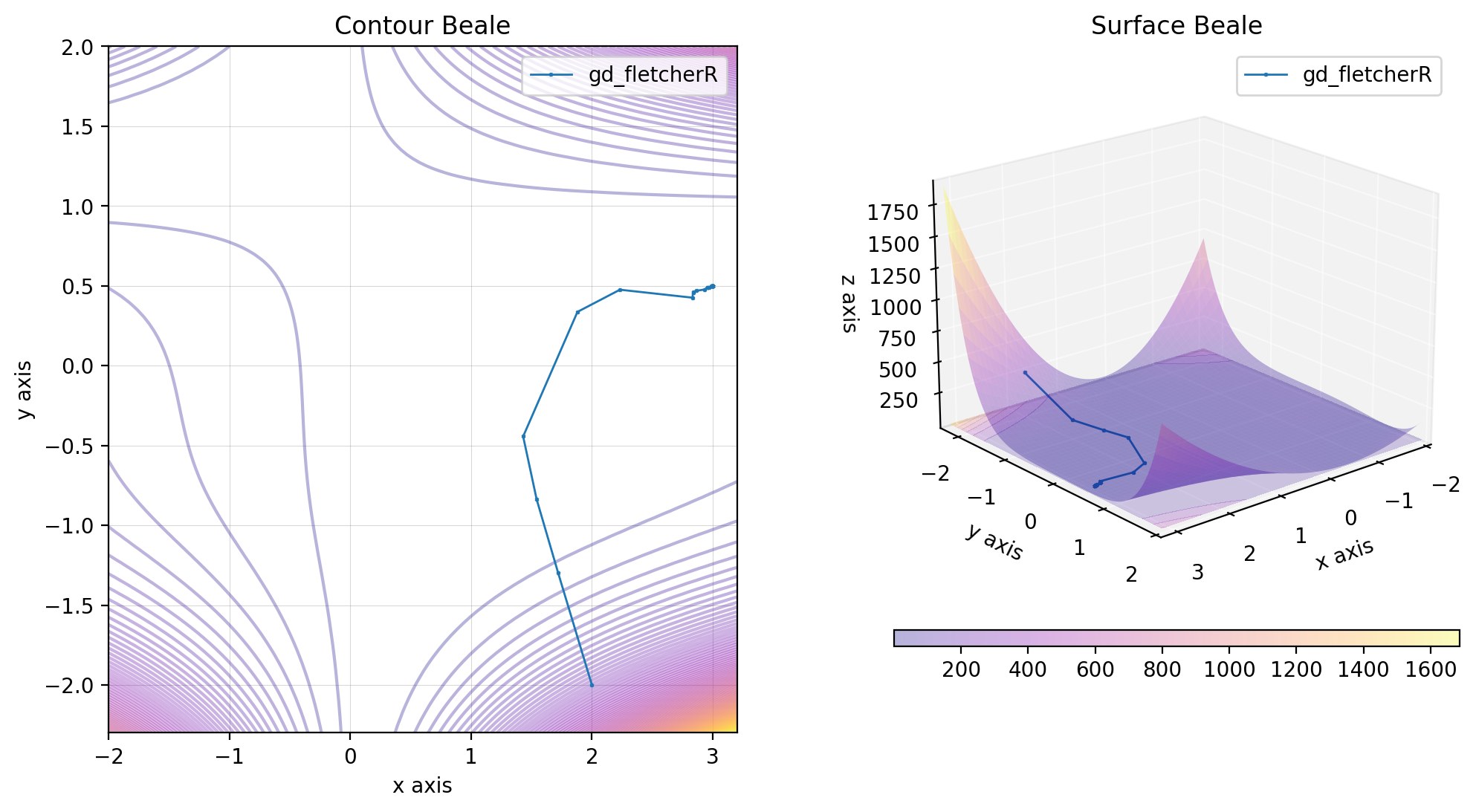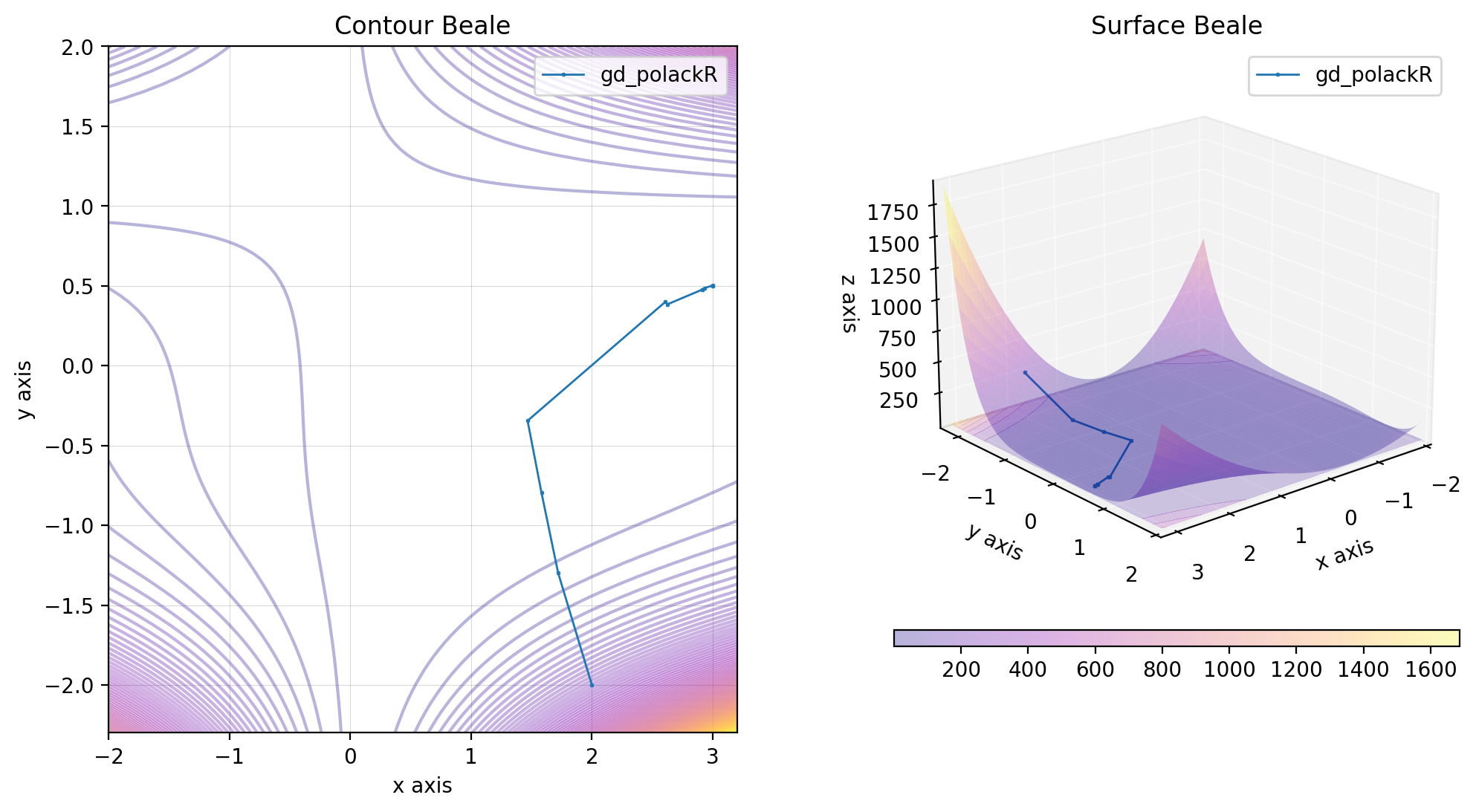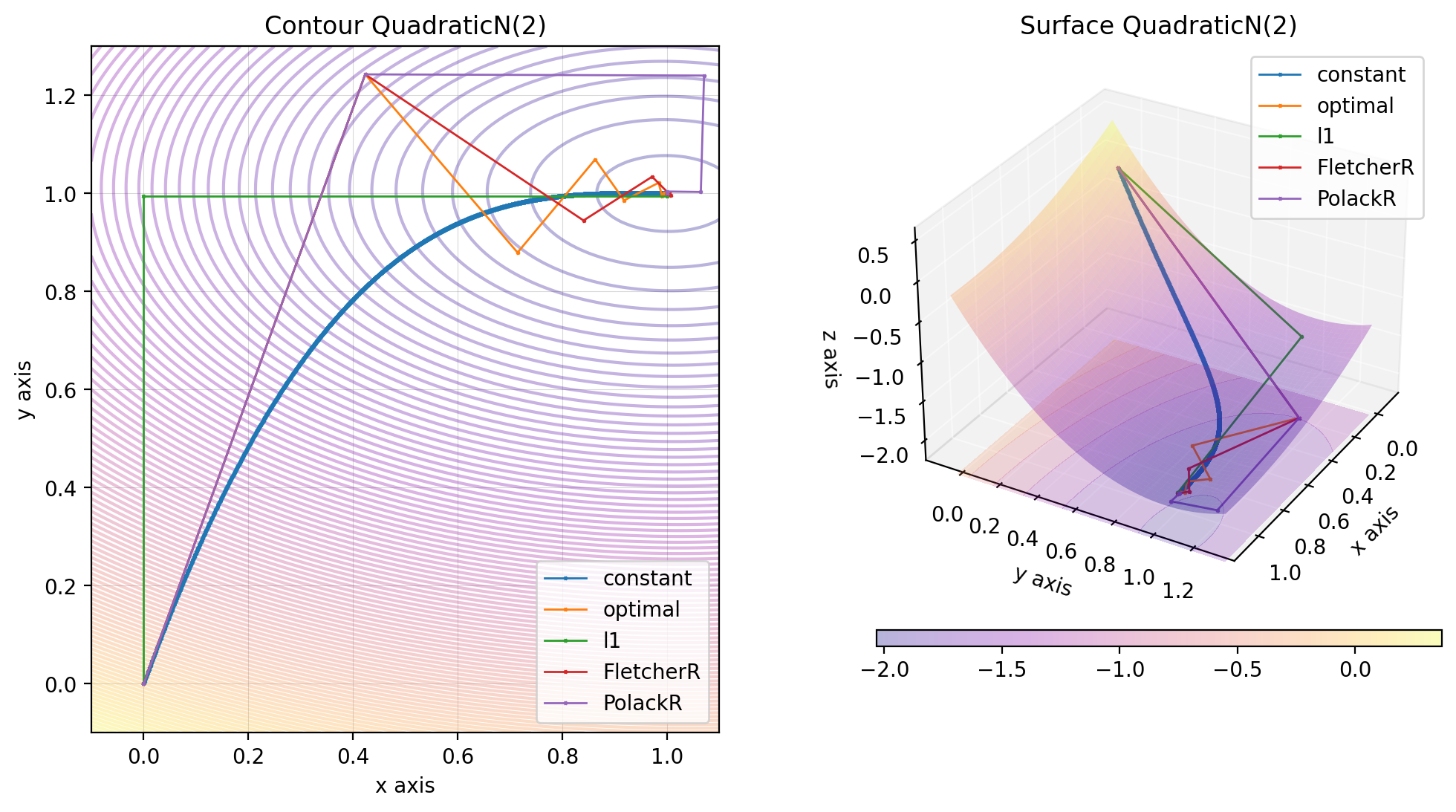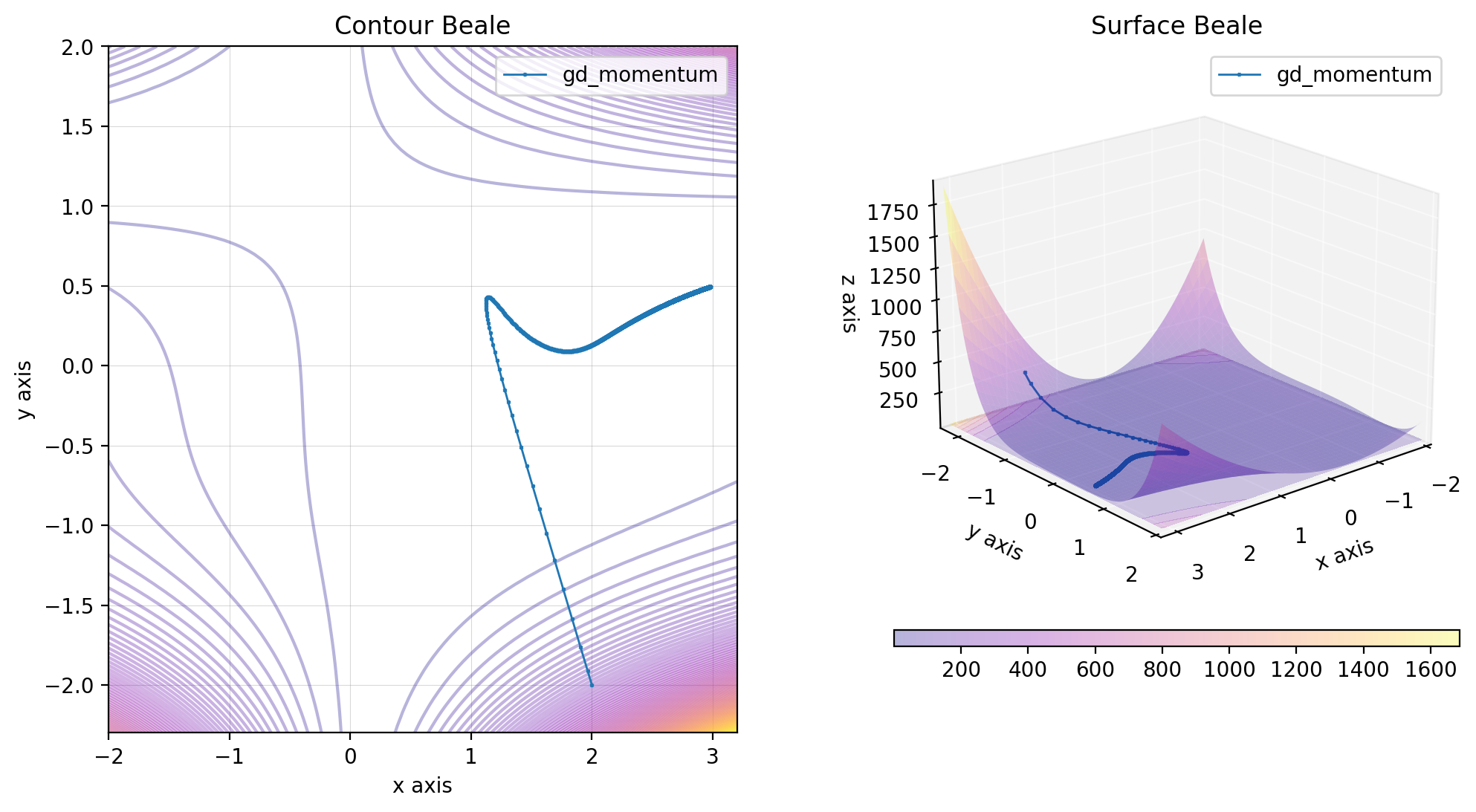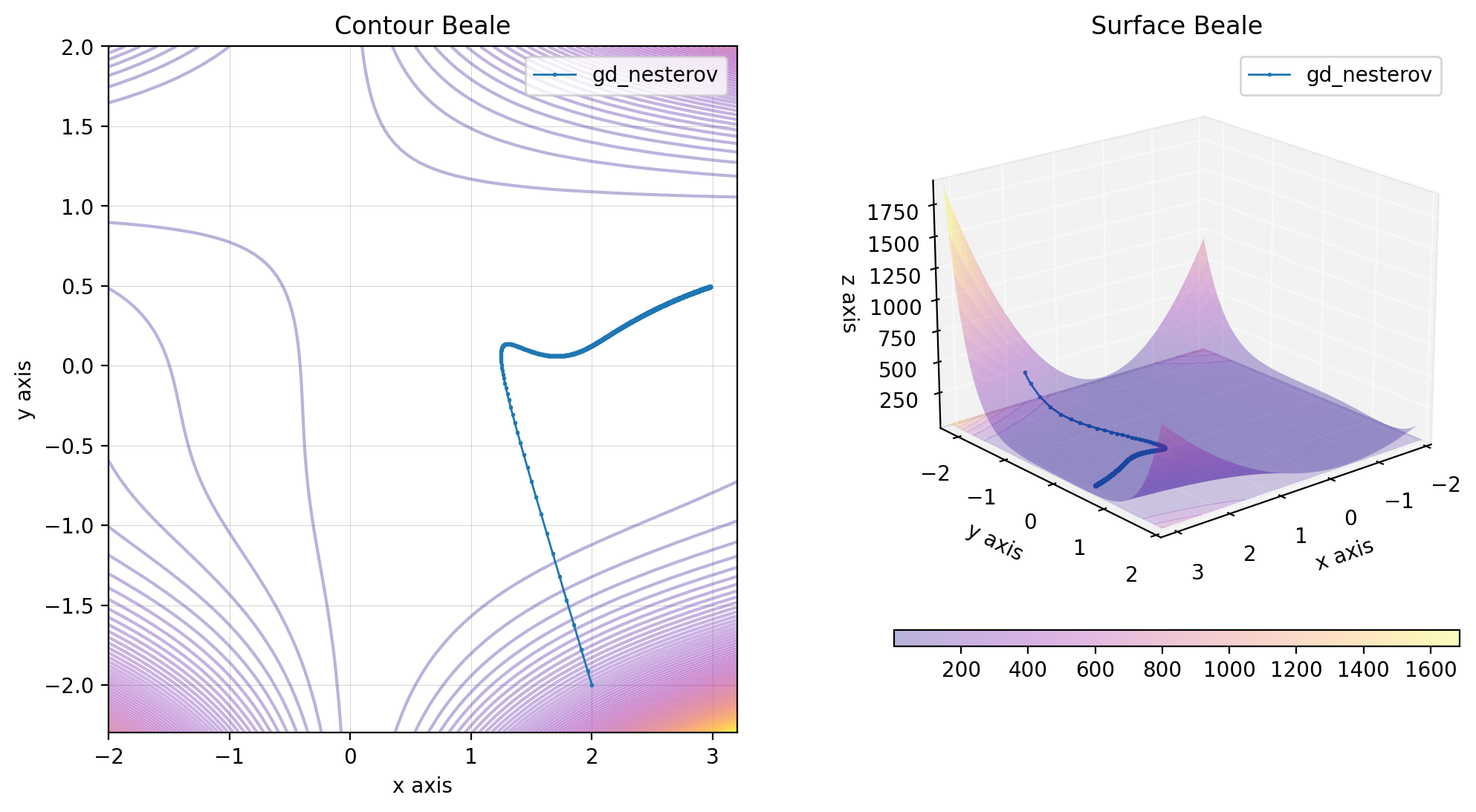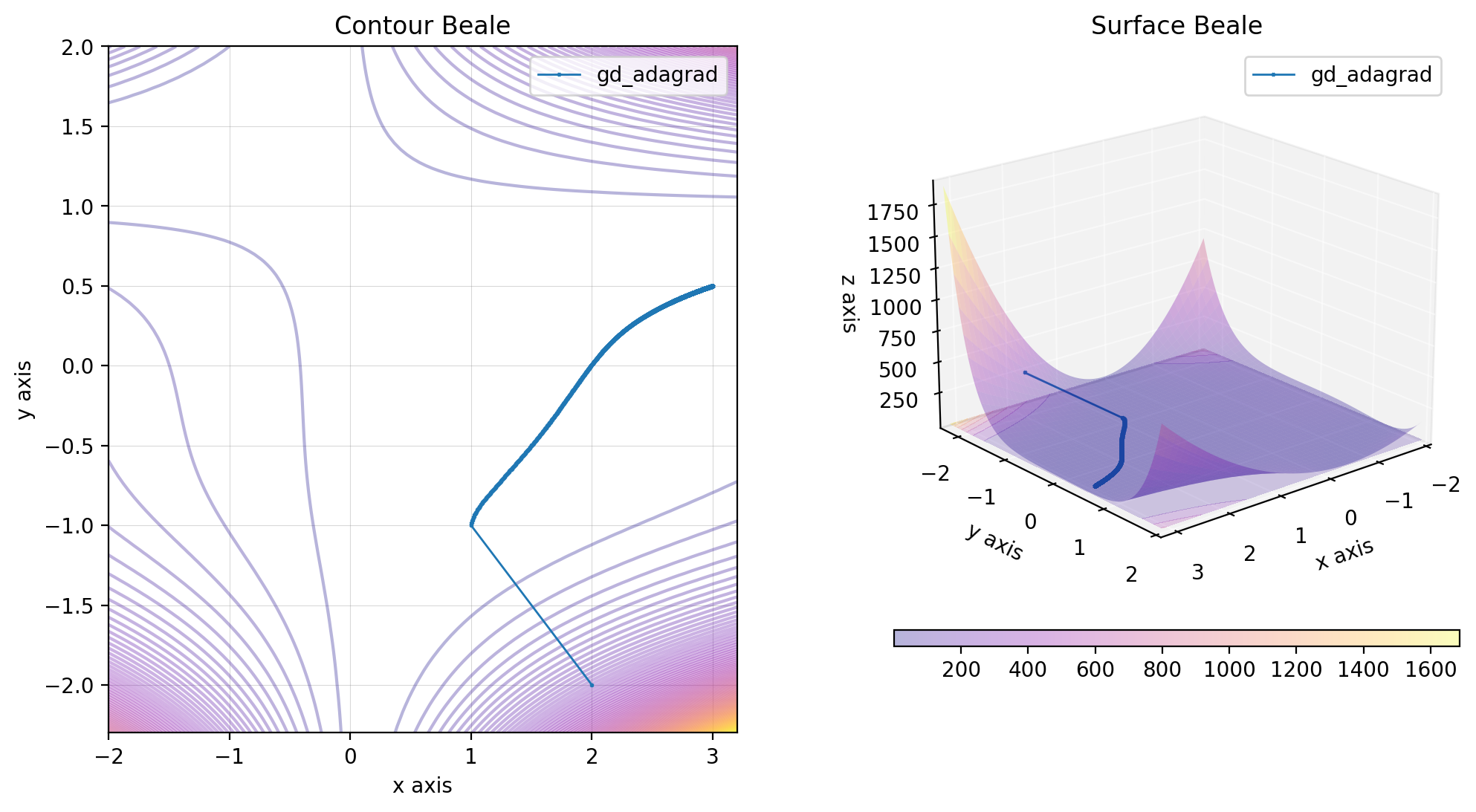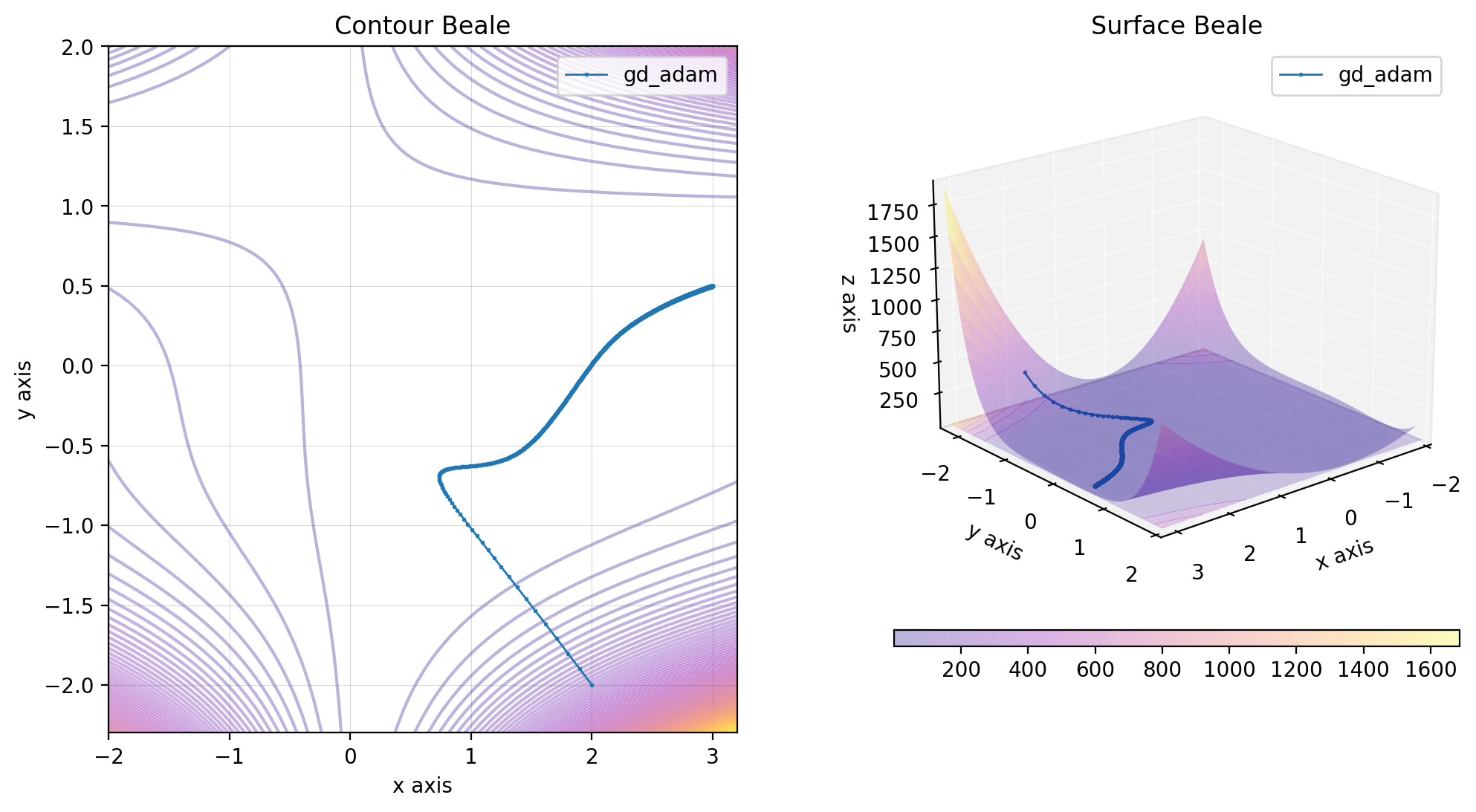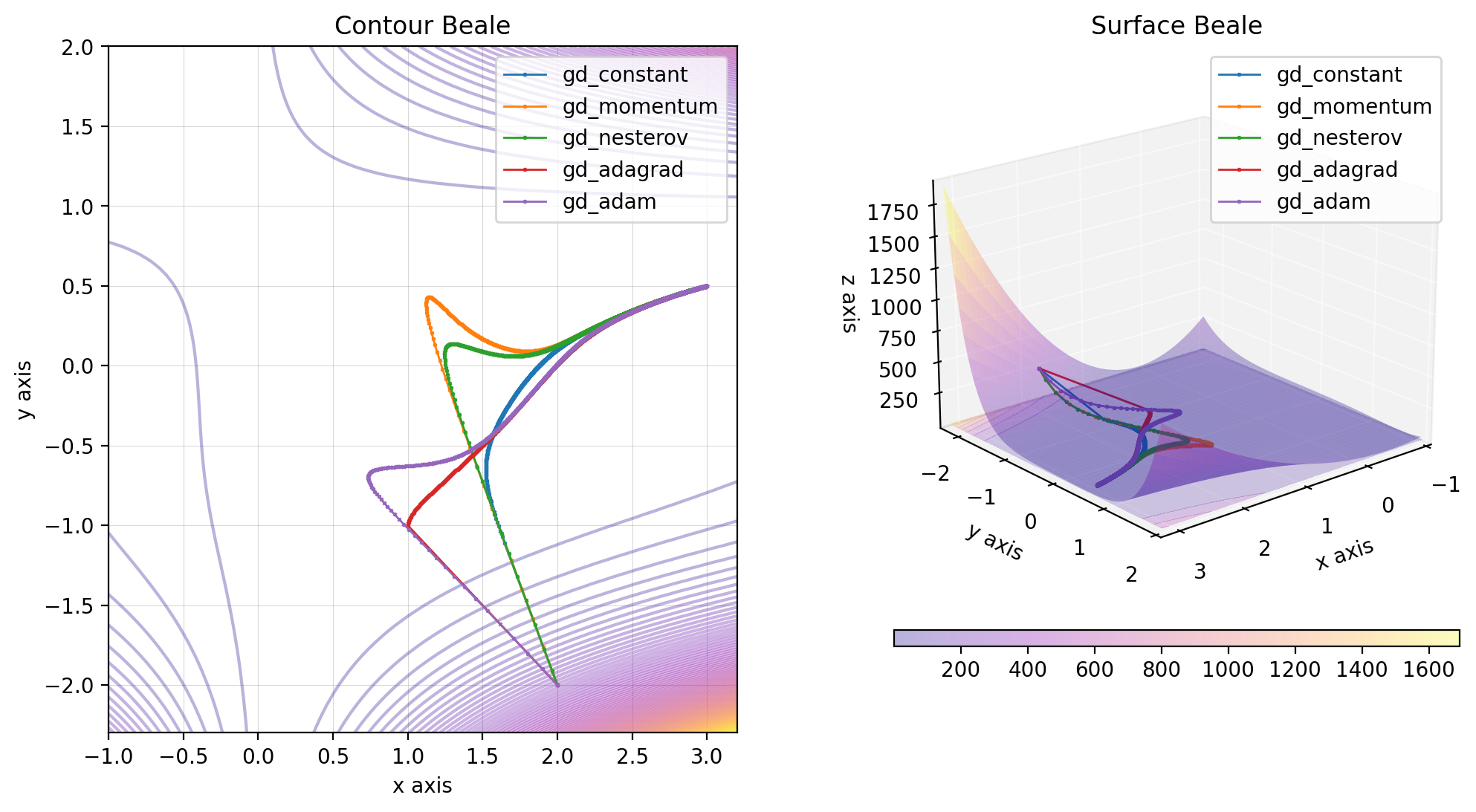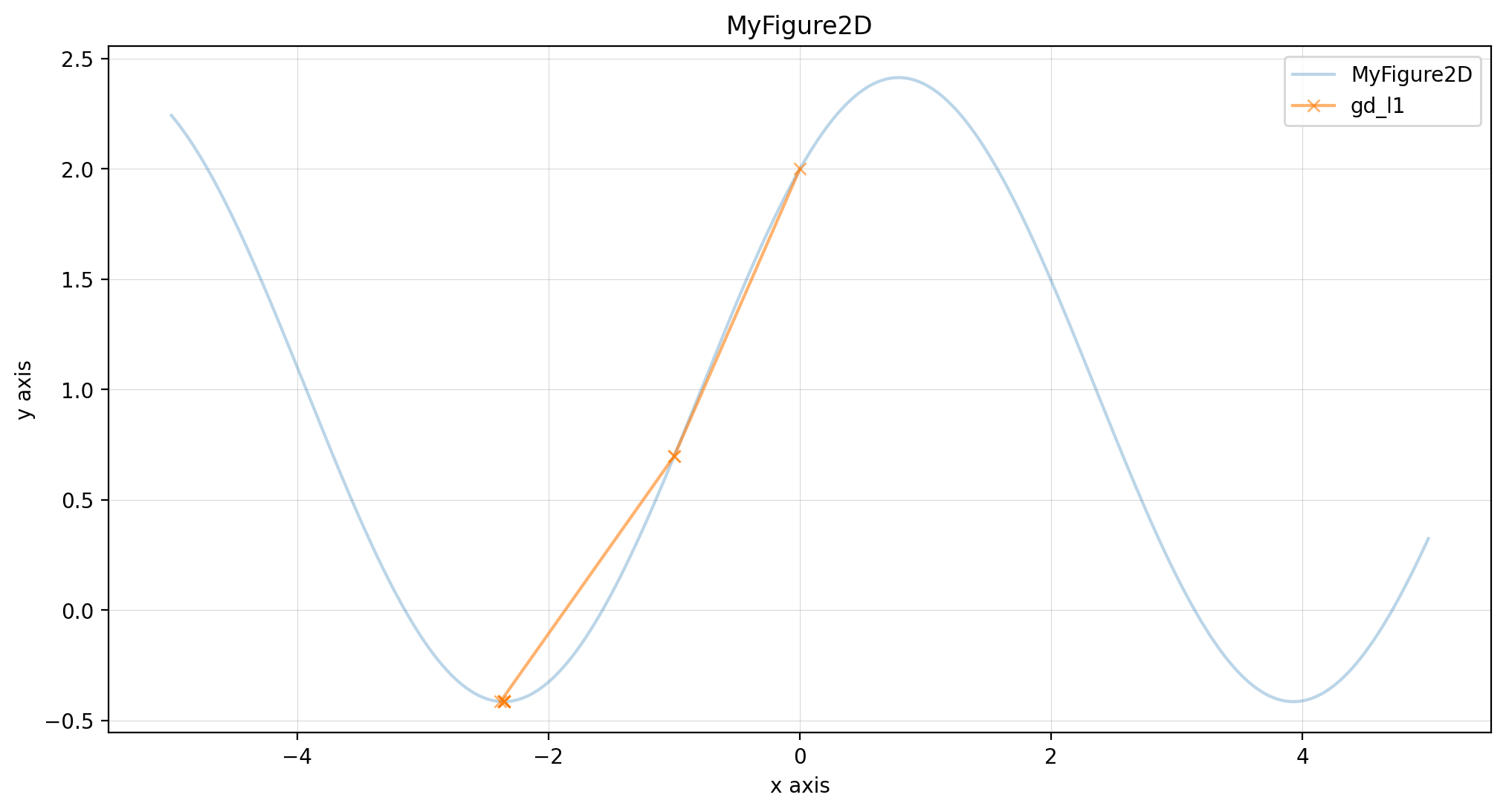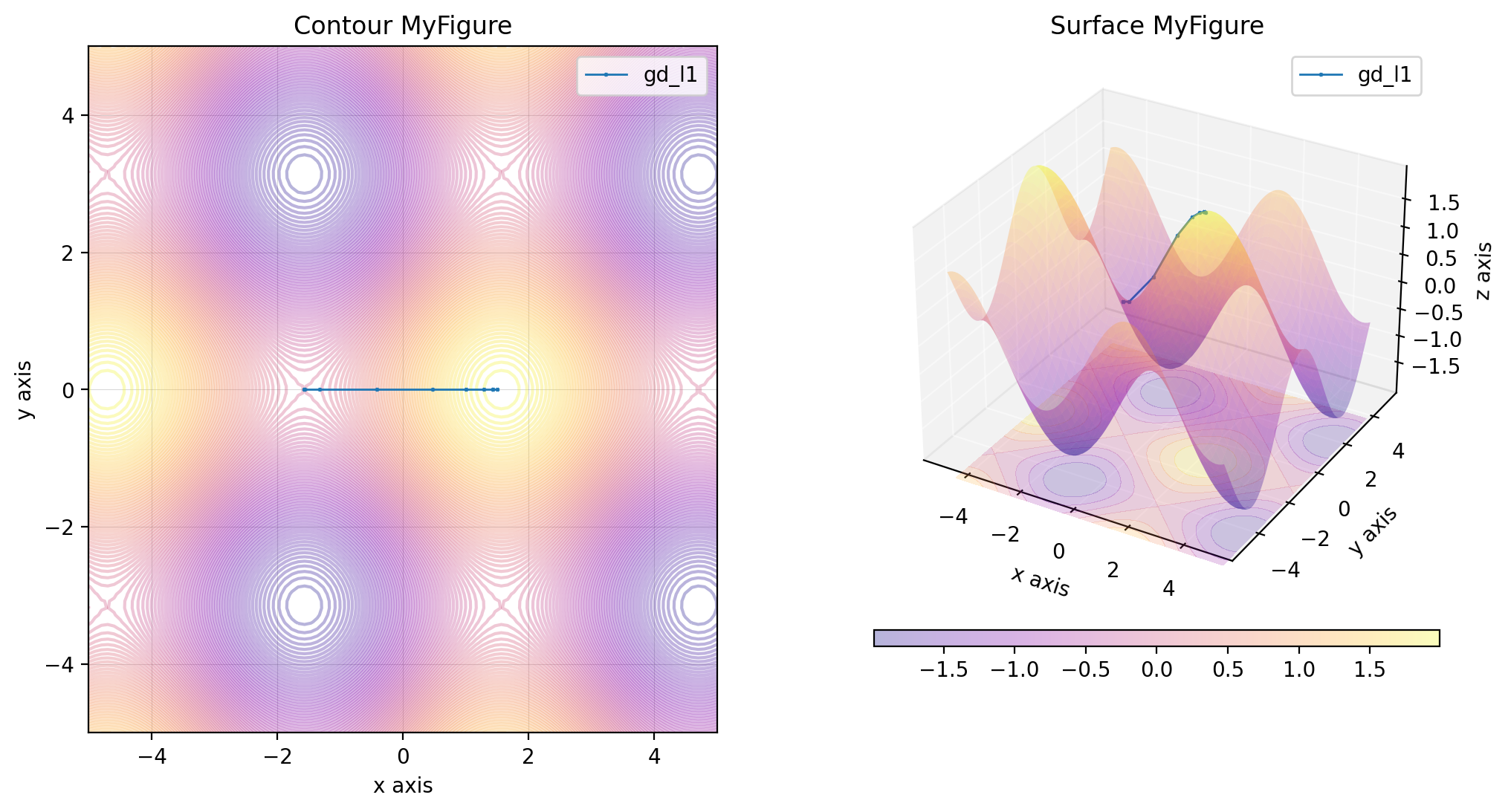This project aims to display any function
Some functions have already been implemented and can be use as followed.
import numpy as np
from descent.figure3d import Cubic3D
cubic_3d = Cubic3D(np.array([10, 10]))
x = np.linspace(-10, 5, 100)
X = np.stack((x, x), axis=-1)
cubic_3d.figure(X, plot_contour=True)Some
This function can be used as followed:
from descent.figure2d import Quadratic2D, Cubic2D, Multitrous2D
quadratic_2d = Quadratic2D()
cubic_2d = Cubic2D()
multitrous_2d = Multitrous2D()Some
This function can be used as followed:
from descent.figure3d import Quadratic3D, Cubic3D, Multitrous3D, Rosenbrock, QuadraticN, Chips, Beale
quadratic_3d = Quadratic3D()
cubic_3d = Cubic3D()
multitrous_3d = Multitrous3D()
rosenbrock = Rosenbrock()
quadratic_n = QuadraticN() # Quadratic function but with a different conditionning
chips = Chips()
beale = Beale()Different gradient descent methods have been implemented and can be used.
To implement Gradient Descent with a fixed step, we begin by selecting a constant step size (learning rate), denoted as
As long as the norm
- Compute the gradient of the objective function
$J$ at the current point:$\nabla J({\bf p}_k)$ . - Choose a descent direction
${\bf d}_k = - \nabla J({\bf p}_k)$ . - Move in this direction:
${\bf p}_{k+1} = {\bf p}_k + \eta {\bf d}_k$ .
import numpy as np
from descent.figure3d import Beale
from descent.gradient import GradientDescentConstant
beale = Beale()
x0 = np.array([2, -2])
lr = 0.001
x = np.linspace(-2, 3.2, 100)
y = np.linspace(-2.3, 2, 100)
X = np.stack((x, y), axis=-1)
gd_constant = GradientDescentConstant()
res_gd_constant = gd_constant(beale, x0, lr)
descent = {
"gd_constant": res_gd_constant
}
beale.figure(X, descent=descent, plot_contour=True, view=(20, 50))To enhance the convergence of the algorithm, we introduce a variable learning rate
To ensure the convergence of the sequence
We seek a
A suitable
The Armijo Rule is implemented as follows:
- Start with an initial value
$\eta = 1$ . - While condition
$(1)$ is not satisfied:- Adjust
$\eta$ to$\beta \eta$ .
- Adjust
The algorithm is the same as the one with a fixed step, except for the learning rate
As long as the norm
- Compute the gradient of the objective function
$J$ at the current point:$\nabla J({\bf p}_k)$ . - Choose a descent direction
${\bf d}_k = - \nabla J({\bf p}_k)$ . - Compute the learning rate
$\eta$ using the Armijo rule. - Move in this direction:
${\bf p}_{k+1} = {\bf p}_k + \eta {\bf d}_k$ .
import numpy as np
from descent.figure3d import Beale
from descent.gradient import GradientDescentOptimalStep
beale = Beale()
x0 = np.array([2, -2])
x = np.linspace(-2, 3.2, 100)
y = np.linspace(-2.3, 2, 100)
X = np.stack((x, y), axis=-1)
gd_optimal = GradientDescentOptimalStep()
res_gd_optimal = gd_optimal(beale, x0)
descent = {
"gd_optimal": res_gd_optimal,
}
beale.figure(X, descent=descent, plot_contour=True, view=(20, 50))In L1 optimization, the descent direction is not necessarily
Here, we choose the steepest descent in the case of the
where
The algorithm is the same as the one with an optimal step, except for the descent direction
As long as the norm
- Compute the gradient of the objective function
$J$ at the current point:$\nabla J({\bf p}_k)$ . - Choose a descent direction
${\bf d}_k$ =$-\langle \nabla J({\bf p}_k),e_i \rangle , e_i$ . - Compute the learning rate
$\eta$ using the Armijo rule. - Move in this direction:
${\bf p}_{k+1} = {\bf p}_k + \eta {\bf d}_k$ .
import numpy as np
from descent.figure3d import Beale
from descent.gradient import GradientDescentL1Optimisation
beale = Beale()
x0 = np.array([2, -2])
x = np.linspace(-2, 3.2, 100)
y = np.linspace(-2.3, 2, 100)
X = np.stack((x, y), axis=-1)
gd_l1 = GradientDescentL1Optimisation()
res_gd_l1 = gd_l1(beale, x0)
descent = {
"gd_l1": res_gd_l1,
}
beale.figure(X, descent=descent, plot_contour=True, view=(20, 50))In the Fletcher-Reeves method, the descent direction is modified by adding to the opposite of the gradient a term that depends on the previous descent directions. This choice of descent is made to make two descent directions orthogonal for the scalar product that comes from the Hessian.
The algorithm is the same as the one with an optimal step, except for the descent direction
As long as the norm
- Choose a descent direction
${\bf d}_k$ using the Fletcher-Reeves method. - Compute the learning rate
$\eta$ using the Armijo rule. - Move in this direction:
${\bf p}_{k+1} = {\bf p}_k + \eta {\bf d}_k$ .
import numpy as np
from descent.figure3d import Beale
from descent.gradient import GradientDescentFletcherReeves
beale = Beale()
x0 = np.array([2, -2])
x = np.linspace(-2, 3.2, 100)
y = np.linspace(-2.3, 2, 100)
X = np.stack((x, y), axis=-1)
gd_fletcherR = GradientDescentFletcherReeves()
res_gd_fr = gd_fletcherR(beale, x0)
descent = {
"gd_fletcherR": res_gd_fr,
}
beale.figure(X, descent=descent, plot_contour=True, view=(20, 50))An alternative method is that proposed by Polack-Ribière.
The algorithm is the same as the one with an optimal step, except for the descent direction
As long as the norm
- Choose a descent direction
${\bf d}_k$ using the Polack-Ribière method. - Compute the learning
$\eta$ using the Armijo rule. - Move in this direction:
${\bf p}_{k+1} = {\bf p}_k + \eta {\bf d}_k$ .
import numpy as np
from descent.figure3d import Beale
from descent.gradient import GradientDescentPolackRibiere
beale = Beale()
x0 = np.array([2, -2])
x = np.linspace(-2, 3.2, 100)
y = np.linspace(-2.3, 2, 100)
X = np.stack((x, y), axis=-1)
gd_polackR = GradientDescentPolackRibiere()
res_gd_pr = gd_polackR(beale, x0)
descent = {
"gd_polackR": res_gd_pr,
}
beale.figure(X, descent=descent, plot_contour=True, view=(20, 50))You can plot the different gradient descent methods on the same figure as followed:
import numpy as np
from descent.figure3d import QuadraticN
from descent.gradient import GradientDescentConstant
from descent.gradient import GradientDescentOptimalStep
from descent.gradient import GradientDescentL1Optimisation
from descent.gradient import GradientDescentFletcherReeves
from descent.gradient import GradientDescentPolackRibiere
from descent.functions import create_system
A, b = create_system(2, 3)
x_exact = np.ones(2, dtype=np.float64)
b = A @ x_exact
x0 = np.zeros(2, dtype=np.float64)
quadratic_n = QuadraticN(A, b)
gd_constant = GradientDescentConstant()
res_constant = gd_constant(quadratic_n, x0, mu = 0.9 / 1000)
gd_optimal = GradientDescentOptimalStep()
res_optimal = gd_optimal(quadratic_n, x0)
gd_l1 = GradientDescentL1Optimisation()
res_l1 = gd_l1(quadratic_n, x0)
gd_fr = GradientDescentFletcherReeves()
res_fr = gd_fr(quadratic_n, x0)
gd_pr = GradientDescentPolackRibiere()
res_pr = gd_pr(quadratic_n, x0)
x, y = np.linspace(-0.1, 1.1, 150), np.linspace(-0.1, 1.3, 150)
X = np.stack((x, y), axis=-1)
descent = {
'constant': res_constant,
'optimal': res_optimal,
'l1': res_l1,
'FletcherR': res_fr,
'PolackR': res_pr
}
quadratic_n.figure(X, descent=descent, plot_contour=True, view=(30, 30))Momentums are used to accelerate the convergence of the gradient descent. The idea is to add a term to the descent direction that depends on the previous descent directions. It helps to optimise non convex functions.
The gradient descent with momentum is defined by the following relation:
Where
As long as the norm
- Choose a descent direction
${\bf d}_k$ using the previous method. - Move in this direction:
${\bf p}_{k+1} = {\bf p}_k - \eta {\bf d}_k$ .
import numpy as np
from descent.figure3d import Beale
from descent.gradient import GradientDescentMomentumAcceleration
beale = Beale()
x0 = np.array([2, -2])
x = np.linspace(-2, 3.2, 100)
y = np.linspace(-2.3, 2, 100)
X = np.stack((x, y), axis=-1)
gd_momentum = GradientDescentMomentumAcceleration()
res_gd_momentum = gd_momentum(beale, x0, lr=0.0001)
descent = {
"gd_momentum": res_gd_momentum,
}
beale.figure(X, descent=descent, plot_contour=True, view=(20, 50))The gradient descent with Nesterov momentum is defined by the following relation:
Where
As long as the norm
- Choose a descent direction
${\bf d}_k$ using the previous method. - Move in this direction:
${\bf p}_{k+1} = {\bf p}_k - {\bf d}_k$ .
import numpy as np
from descent.figure3d import Beale
from descent.gradient import GradientDescentNesterovAcceleration
beale = Beale()
x0 = np.array([2, -2])
x = np.linspace(-2, 3.2, 100)
y = np.linspace(-2.3, 2, 100)
X = np.stack((x, y), axis=-1)
gd_nesterov = GradientDescentNesterovAcceleration()
res_gd_nesterov = gd_nesterov(beale, x0, lr=0.0001)
descent = {
"gd_nesterov": res_gd_nesterov,
}
beale.figure(X, descent=descent, plot_contour=True, view=(20, 50))The gradient descent with Adagrad acceleration is defined by the following relations:
Where
As long as the norm
- Choose a descent direction
${\bf d}_k$ using the previous method. - Move in this direction:
${\bf p}_{k+1} = {\bf p}_k - \eta{\bf d}_k$ .
import numpy as np
from descent.figure3d import Beale
from descent.gradient import GradientDescentAdagrad
beale = Beale()
x0 = np.array([2, -2])
x = np.linspace(-2, 3.2, 100)
y = np.linspace(-2.3, 2, 100)
X = np.stack((x, y), axis=-1)
gd_adagrad = GradientDescentAdagrad()
res_gd_adagrad = gd_adagrad(beale, x0, lr=1)
descent = {
"gd_adagrad": res_gd_adagrad,
}
beale.figure(X, descent=descent, plot_contour=True, view=(20, 50))The gradient descent with Adam acceleration is defined by the following relations:
Where
As long as the norm
- Choose a descent direction
${\bf d}_k$ using the previous method. - Move in this direction:
${\bf p}_{k+1} = {\bf p}_k - \eta{\bf d}_k$ .
import numpy as np
from descent.figure3d import Beale
from descent.gradient import GradientDescentAdam
beale = Beale()
x0 = np.array([2, -2])
x = np.linspace(-2, 3.2, 100)
y = np.linspace(-2.3, 2, 100)
X = np.stack((x, y), axis=-1)
gd_adam= GradientDescentAdam()
res_gd_adam = gd_adam(beale, x0, lr=0.1)
descent = {
"gd_adam": res_gd_adam,
}
beale.figure(X, descent=descent, plot_contour=True, view=(20, 50))You can plot the different gradient descent methods with momentum on the same figure as followed:
import numpy as np
from descent.gradient import GradientDescentConstant
from descent.gradient import GradientDescentMomentumAcceleration
from descent.gradient import GradientDescentNesterovAcceleration
from descent.gradient import GradientDescentAdagrad
from descent.gradient import GradientDescentAdam
from descent.figure3d import Beale
beale = Beale()
x0 = np.array([2, -2])
x = np.linspace(-1, 3.2, 100)
y = np.linspace(-2.3, 2, 100)
X = np.stack((x, y), axis=-1)
gd_constant = GradientDescentConstant()
res_gd_constant = gd_constant(beale, x0, lr=0.001)
gd_momentum = GradientDescentMomentumAcceleration()
res_gd_momentum = gd_momentum(beale, x0, lr=0.0001)
gd_nesterov = GradientDescentNesterovAcceleration()
res_gd_nesterov = gd_nesterov(beale, x0, lr=0.0001)
gd_adagrad = GradientDescentAdagrad()
res_gd_adagrad = gd_adagrad(beale, x0, lr=1)
dg_adam = GradientDescentAdam()
res_gd_adam = gd_adam(beale, x0, lr=0.1)
descents = {
"gd_constant": res_gd_constant,
"gd_momentum": res_gd_momentum,
"gd_nesterov": res_gd_nesterov,
"gd_adagrad": res_gd_adagrad,
"gd_adam": res_gd_adam,
}
beale.figure(X, descent=descents, plot_contour=True, view=(20, 50))You can add your own figures and try different gradient descent methods on it simply by creating a new class that inherits from the Figure class.
import numpy as np
from descent.figure2d import Figure2D
from descent.gradient import GradientDescentL1Optimisation
class MyFigure2D(Figure2D):
def __name__(self) -> str:
return "MyFigure2D"
def __init__(self, alpha: float = 0.0):
self.alpha = alpha
def function(self, x: np.array) -> np.array:
return np.sin(x) + np.cos(x) + self.alpha
my_figure = MyFigure2D(1)
x0 = np.array([0])
opti = GradientDescentL1Optimisation()
res_opti = opti(my_figure, x0)
descents = {
"gd_l1": res_opti,
}
my_figure.figure(descent=descents)import numpy as np
from descent.figure3d import Figure3D
from descent.gradient import GradientDescentL1Optimisation
class MyFigure3D(Figure3D):
def __name__(self) -> str:
return "MyFigure"
def function(self, x: np.array) -> np.array:
return np.sin(x[0]) + np.cos(x[1])
my_figure = MyFigure3D()
x0 = np.array([1.5, 0])
opti = GradientDescentL1Optimisation()
res_opti = opti(my_figure, x0)
descents = {
"gd_l1": res_opti,
}
my_figure.figure(plot_contour=True, descent=descents)